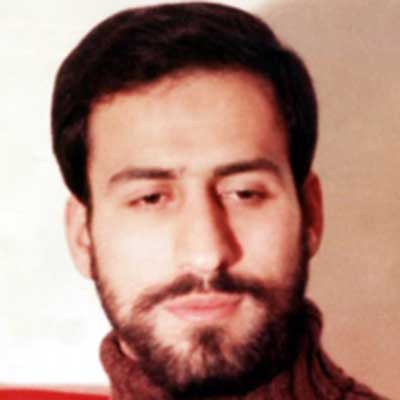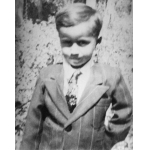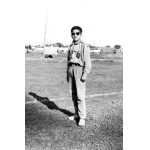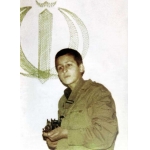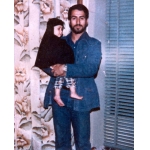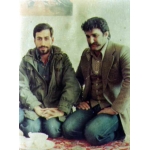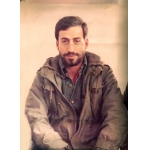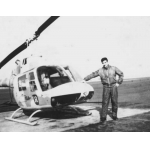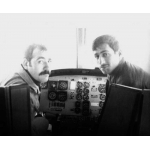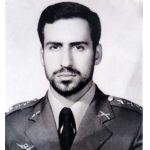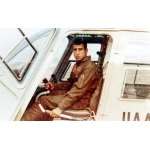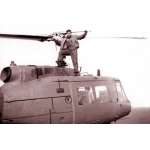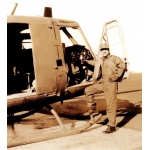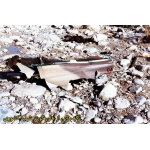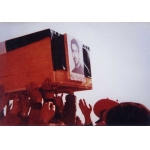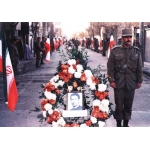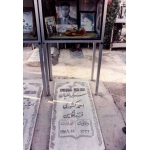Keshvari, Ahmad
Neda Arba
499 بازدید
Ahmad Keshvari (1953-1980) was the commander of the Iranian Army Aviation (Havanirooz) serving in Ilam and Kermanshah during the early years following the Islamic Revolution and the Iran-Iraq War. He attained martyrdom in Ilam.
Ahmad Keshvari was born in July 1953 in the city of Kiakola of the Mazandaran Province. He went to primary school at Khayyam School in Kiakola and to high school in Sarepol-e Talar and Qaneh, Babol.[1]
He won the gold medal in wrestling competitions held in Babol.[2] In 1972, Keshvari was accepted into the University of Tehran to study food science[3] though he decided not to attend.[4] Instead, driven by his passion for aviation,[5] he joined the Havanirooz Headquarters and enrolled in the Tehran 6th Military Base, where he was ranked amongst the top seven pilots.[6]
In April 1973, Keshvari was sent to the Isfahan Base to undergo pilot training and successfully attained a helicopter pilot license on December 19, 1973, becoming the first pilot to fly solo.[7] In the summer of 1974, he was sent to Shiraz for a six-month infantry training course.[8] Keshvari built a helicopter model with colored paper and put it on the wall of the Havanirooz dormitory in Shiraz. Later, it became the sigil of the Havanirooz.[9] In early 1975, after completing his training, he returned to Tehran and was assigned by the Havanirooz headquarters to the combat group in Kermanshah. However, due to the construction in the Kermanshah Base, he remained in Isfahan, where he passed the AH-1 Cobra piloting course.[10]
In early 1975, Keshvari was transferred to the Kermanshah Army Aviation Base.[11] He received his Cobra pilot’s certificate on May 8, 1975, with the rank of third lieutenant.[12] He also organized a community fund with the help of some of his colleagues and the assistance of the Aviation Forces.[13] In 1976, he was appointed commander of a company at the Kermanshah Base,[14] where he engaged in political and religious activities. For engaging in activities against the Shah he was arrested and interrogated by SAVAK.[15] In early 1977, Keshvari married his cousin.[16] They had two children, Maryam and Ali.[17]
In 1977, Keshvari was responsible for commanding pilots and technical personnel at the Kermanshah Army Aviation Base.[18] His first initiative during the Revolution was to organize Quran study at the base.[19] After the victory of the Islamic Revolution on February 11, 1979, Keshvari played a pivotal role in breaking the siege of the Sanandaj Base and protecting bases in Saqqez, Baneh, Marivan, and Sardasht amid the unrest in Kurdistan.[20] On March 19, 1979, amid the ongoing tensions and unrest in the Sanandaj base, and in response to Imam Khomeini’s call for dealing with the opposition groups and factions,[21] Keshvari entered the Sanandaj Base to carry out an operation[22] during which he was wounded. He then returned to Kermanshah.[23]
However, on March 23, 1979, he returned to the Sanandaj base to evacuate the families of military personnel to Kermanshah.[24] In the spring of 1979, he commanded the operations launched to clear the Gahvareh and Islamabad Gharb Mountains.[25] On August 8, 1979, when the city and military base of Paveh were under siege by anti-revolutionary forces and on the verge of falling, Keshvari was ordered by Major General Valiollah Fallahi, the Commander of the Joint Staff of the Islamic Republic of Iran Army, to carry out an operation in Paveh.[26] The third company in which Keshvari served as a pilot, became known as the “Mujahideen Company”.[27] Alongside the Havanirooz team and with the collaboration of Dr. Mustafa Chamran, commander of irregular warfare, the Kurdistan garrison, and Major General Valiollah Fallahi, Keshvari carried out an operation and broke the siege of Paveh and eventually liberated the city on August 17, 1979.[28] He also led the Havanirooz team in clearing operations launched in Kurdistan and successfully liberated the Baneh base, during which he was injured.[29]
In an operation that was conducted along the Saqqez-Gardanah Khan axis, Keshvari led armed helicopters which had to support the 16th Armored Division’s column. They managed to successfully clear the area with the help of Ali Sayyad Shirazi, Commander of Western Operations and pilot Ali Akbar Shiroudi.[30]
On May 27, 1980, Keshvari was dispatched to Saqqez and Baneh to launch an operation, during which his helicopter was hit by enemy fire, and he was wounded.[31] On September 22, 1980, after the outbreak of the Iran-Iraq War, he left the Army Hospital in Tehran and returned to the Havanirooz Base in Kermanshah.[32] There two fire teams were formed by Havanirooz: one led by Shiroudi for the Abuzar Base in Sarpol-e Zahab, and the other, under Keshvari’s command, for the Ghochali Base.[33] The following day, Keshvari launched a combat operation at the Ilam border. During this operation, the Iraqi tank columns advancing from Gilan-e Gharb towards Sarpol-e Zahab and Islamabad were stopped.[34] In addition, Keshvari’s air strikes contributed to the liberation of the strategic Meimak Heights.[35]
At the beginning of the war, Keshvari formed special teams known as “Seek and Destroy”. Their mission was to locate and eliminate enemy forces.[36] He served as the commander of the assault teams during aerial operations. In a mission aimed at pushing back Iraqi forces who had been advancing towards Sarpol-e Zahab, Keshvari’s unit attacked the Iraqi convoy from both the front and behind forcing them to retreat.[37] His family had been with him since the first day he entered the Ilam operational region, and they were staying in the provincial government’s residence.[38]
On December 6, 1980, Keshvari was dispatched to the Meimak for an operation. At 10:25 a.m., his helicopter was attacked by two Iraqi MiG-21S fighter jets and crashed in the Bina Strait[39] resulting in his martyrdom.[40] Funeral ceremonies were held in Ilam, Kermanshah, and Tehran, and on December 9, he was laid to rest in Section 24 of Behesht-e Zahra Cemetery in Tehran.[41] In recognition of this great martyr, the Islamic Republic of Iran Army designated the day of his martyrdom as Army Aviation Day. Major General Valiollah Fallahi described Keshvari as the “Savior of Kurdistan”.[42]
In 1993, a television series titled “Simorgh”, directed by Hossain Qasemi Jami, was produced about the martyred pilots Keshvari and Shiroudi. In 2012, the former city of Kiakola was changed to Simorgh.[43] A memorial dedicated to Ahmad Keshvari and the martyrs of Meimak has been built in the place where Keshvari’s helicopter crashed.[44]
Name: Ahmad Keshvari
Date of birth: July 1953
Place of birth: Kiakola, Mazandaran
Date of marriage: March 1976
Children: 1 daughter named Maryam and 1 son named Ali
Military rank: Commander of the Air Force of Ilam and Kermanshah regions
Date of Martyrdom: December 6, 1980
Place of Martyrdom: Tangeh Bina
Cause of Martyrdom: Attack by two Iraqi MiG planes
Date of burial: December 9, 1980
Tomb: Plot 24, Behesht-e Zahra (S) Cemetry, Tehran
[1] Shahmohammadi, Hojjat, Masoumi, Seyyed Amir, Simorgh, Tehran: Haft, 1999, pp. 11 and 12.
[2] Fallah, Iraj, Ab-Azari, Masoud, Khanehee Koochak Ba Gerdsoozi Roshan (A small house with a bright Round-Light), Tehran: Ya zehra (S), 2011, pp. 33 and 34.
[3] Ab-Azari, Masoud, Chaye Akhar (The Last Tea), Tehran: Aja, 2010, p. 40.
[4] Masoumi, Seyyed Amir, Sahifeh Parvaz, Tehran: Hozeh Honari, 1980, p. 233.
[5] Shahed Yaran, No. 114 and 115, April and May 2015, p. 1.
[6] Ab-Azari, Masoud, Chaye Akhar (The Last Tea), Tehran: Aja, 2010, pp. 40 and 41.
[7] Ibid., pp. 42 and 168.
[8] Ibid., pp. 44 and 45.
[9] Ibid., pp. 7.
[10] Ibid., pp. 75.
[11] Shahed Yaran. P. 1.
[12] Ab-Azari, Masoud, Chaye Akhar (The Last Tea), Tehran: Aja, 2010, p. 167.
[13] Shahmohammadi, Hojjat, Masoumi, Seyyed Amir, Simorgh, Tehran: Haft, 1999, p. 13.
[14] Shahed Yaran. P. 16.
[15] Tavakoli, Yaqoub, Dictionary of Immortals of History, Tehran: Shahed, 2003, p. 329.
[16] Ab-Azari, Masoud, Chaye Akhar (The Last Tea), Tehran: Aja, 2010, pp. 51 and 55.
[17] Fallah, Iraj. Ab-Azari, Masoud, Chaye Akhar (The Last Tea), Tehran: Aja, 2010, p. 75
[18] Shahed Yaran. P. 17.
[19] Ibid., p. 16.
[20] Ibid., p. 1.
[21] Ghozzat, Rahman, Anha Khodi Naboodand, Tehran: Ettelaat, 2010, p. 65.
[22] Shahed Yaran. P. 19.
[23] Ghozzat, Rahman, Anha Khodi Naboodand, pp. 69 and 70.
[24] Shahed Yaran. P. 19.
[25] Muezzin Jami, Abdul Hamid, Bar Balhaye Simorgh, Tehran: Aja, 2006, p. 20.
[26] Shahed Yaran. P. 9.
[27] Ghozzat, Rahman, Anha Khodi Naboodand, p. 328.
[28] Ibid., p. 345.
[29] Ibid., pp. 233 and 234.
[30] Ibid., p. 233.
[31] Ibid., pp. 231, 239 and 242
[32] Shahed Yaran, pp. 10,11,21 and 22.
[33] Ibid., pp. 25,69 and 72.
[34] Ibid., pp. 10,11,21 and 22.
[35] Ibid., pp.21,22 and 23.
[36] Ab-Azari, Masoud, Uboor Az Bohran (Crossing the Crisis), Tehran: Organization for Preservation and Propagation of Sacred Defense Values of the Army of the Islamic Republic of Iran, 2007, p. 47.
[37] Sajjadi Ansari, Ali, Hossein Ahmadi, Ali, Farmandehane Defa'a Moqaddas (Commanders of the Sacred Defense): Military Genius and Creativity, Tehran: Aja, 2010, pp. 118 and 119.
[38] Shahed Yaran. P. 46.
[39] Behrouzi, Farhad, Calendar of the History of the Sacred Defense, Vol. 4; Establishing the Aggressor, Tehran: Islamic Revolution Documents Center, 2006, pp. 344 and 345.
[40] Shahed Yaran p. 11.
[41] Fallah, Iraj. Ab-Azari, Masoud, Khanehee Koochak Ba gerdsooze Roshan. Pp. 26 and 36.
[42] Shahed Yaran. Pp. 1 and 8.
[43] Ibid,. pp. 55 and 39.
[44] Ibid,. p. 37.


